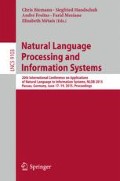Abstract
In this paper, investigations of Sentiment Analysis over a well-known Social Media Twitter were done. As literatures show that some works related to Twitter Sentiment Analysis have been done and delivered interesting idea of features, but there is no a comparative study that shows the best features in performing Sentiment Analysis. In total we used 9 feature sets (41 attributes) that comprise punctuation, lexical, part of speech, emoticon, SentiWord lexicon, AFINN-lexicon, Opinion lexicon, Senti-Strength method, and Emotion lexicon. Feature analysis was done by conducting supervised classification for each feature sets and continued with feature selection in subjectivity and polarity domain. By using four different datasets, the results reveal that AFINN lexicon and Senti-Strength method are the best current approaches to perform Twitter Sentiment Analysis.
Access this chapter
Tax calculation will be finalised at checkout
Purchases are for personal use only
References
Bravo-Marquez, F., Mendoza, M., Poblete, B.: Combining strengths, emotions and polarities for boosting Twitter sentiment analysis. In: Proceedings of the Second International Workshop on Issues of Sentiment Discovery and Opinion Mining, vol. 2 (2013)
Raaijmakers, S., Kraaij, W.: A shallow approach to subjectivity classification. In: ICWSM (2008)
Aisopos, F., Papadakis, G., Tserpes, K., Varvarigou, T.: Content vs. context for sentiment analysis: a comparative analysis over microblogs. In: Proceedings of the 23rd ACM Conference on Hypertext and Social Media, pp. 187–196 (2012)
Go, A., Bhayani, R., Huang, L.: Twitter sentiment classification using distant supervision. In: CS224N Project Report, Stanford (2009)
Agarwal, A., Xie, B., Vovsha, I., Rambow, O., Passonneau, R.: Sentiment analysis of twitter data. In: Proceedings of the Workshop on Languages in Social Media, pp. 30–38 (2011)
Wilson, T., Wiebe, J., Hoffmann, P.: Recognizing contextual polarity in phrase-level sentiment analysis. In: Proceedings of the Conference on Human Language Technology and Empirical Methods in Natural Language Processing, pp. 347–354 (2005)
Liu, B., Hu, M., Cheng, J.: Opinion observer: analyzing and comparing opinions on the web. In: Proceedings of the 14th International Conference on World Wide Web, pp. 342–351 (2005)
Baccianella, S., Esuli, A., Sebastiani, F.: SentiWordNet 3.0: an enhanced lexical resource for sentiment analysis and opinion mining. In: LREC, vol. 10, pp. 2200–2204 (2010)
Bradley, M.M., Lang, P.J.: Affective norms for English words (ANEW): instruction manual and affective ratings. In: Technical report C-1, The Center for Research in Psychophysiology, University of Florida, pp. 1–45 (1999)
Nielsen, F.A.: A new ANEW: evaluation of a word list for sentiment analysis in microblogs. in: arXiv preprint arXiv: 1103.2903 (2011)
Mohammad, S.M., Turney, P.D.: Crowdsourcing a wordemotion association lexicon. Comput. Intell. 29(3), 436–465 (2013)
Thelwall, M., Buckley, K., Paltoglou, G.: Sentiment strength detection for the social web. J. Am. Soc. Inf. Sci. Technol. 63(1), 163–173 (2012)
Ekman, P.: An argument for basic emotions. Cogn. Emot. 6(3–4), 169–200 (1992)
Plutchik, R.: The Psychology and Biology of Emotion. HarperCollins College Publishers, New York (1994)
Speriosu, M., Sudan, N., Upadhyay, S., Baldridge, J.: Twitter polarity classification with label propagation over lexical links and the follower graph. In: Proceedings of the First workshop on Unsupervised Learning in NLP, pp. 53–63 (2011)
Bird, S.: NLTK: the natural language toolkit. In: Proceedings of the COLING/ACL on Interactive Presentation Sessions, pp. 69–72 (2006)
Author information
Authors and Affiliations
Corresponding author
Editor information
Editors and Affiliations
Rights and permissions
Copyright information
© 2015 Springer International Publishing Switzerland
About this paper
Cite this paper
Koto, F., Adriani, M. (2015). A Comparative Study on Twitter Sentiment Analysis: Which Features are Good?. In: Biemann, C., Handschuh, S., Freitas, A., Meziane, F., Métais, E. (eds) Natural Language Processing and Information Systems. NLDB 2015. Lecture Notes in Computer Science(), vol 9103. Springer, Cham. https://doi.org/10.1007/978-3-319-19581-0_46
Download citation
DOI: https://doi.org/10.1007/978-3-319-19581-0_46
Published:
Publisher Name: Springer, Cham
Print ISBN: 978-3-319-19580-3
Online ISBN: 978-3-319-19581-0
eBook Packages: Computer ScienceComputer Science (R0)

